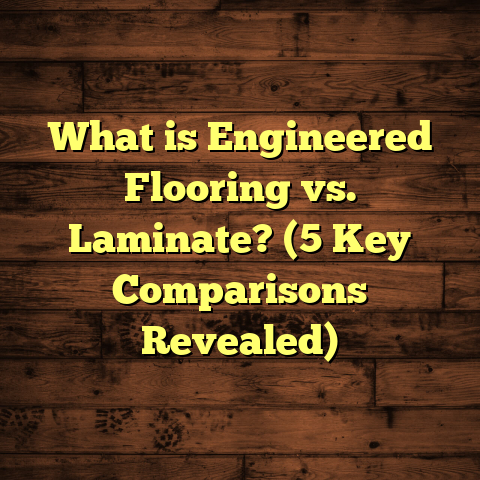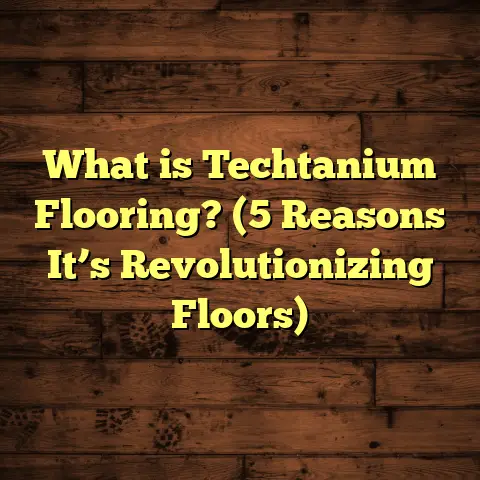What is Travertine Floor Tile? (5 Unique Benefits for Your Home)
Trends in flooring have shifted significantly over the last decade. I’ve noticed more homeowners gravitating away from synthetic materials and looking for natural options that not only look fantastic but also offer long-term value. Travertine floor tile has surged in popularity among these choices. It’s not just a fleeting trend—there’s a solid reason behind this stone’s comeback in modern homes.
If you’re curious about what travertine floor tile is and why so many people are choosing it for their homes, let me walk you through its story, its benefits, and everything I’ve learned from years of working with this stone.
What Is Travertine Floor Tile?
Travertine is a sedimentary rock formed over thousands of years by mineral deposits from natural springs. Specifically, it’s a type of limestone made primarily of calcium carbonate. The formation happens when mineral-rich water evaporates, leaving behind layers of calcite and other minerals. This slow process creates natural holes and cavities in the stone.
Those tiny holes give travertine its distinctive texture and appearance. When transformed into floor tiles, these holes can be either filled or left open, depending on the finish desired. The filling usually involves using resins or cement-based fillers to create a smoother surface.
Travertine tiles come in various finishes:
- Polished: A shiny surface that highlights the stone’s colors but can be slippery.
- Honed: Matte finish with minimal shine; reduces slipperiness.
- Tumbled: Provides an aged, rustic look with softened edges.
- Brushed: Offers texture by brushing the surface for a worn effect.
Its color ranges from creamy whites and beiges to darker browns, reds, and even golds. This natural variation means each tile has its unique character.
Historically, travertine has been a favored material for architectural marvels such as the Colosseum in Rome. Its timeless appeal has lasted centuries, proving its durability and aesthetic value.
1. Timeless Natural Beauty That Adds Character
There’s something special about natural stone floors that synthetic materials can’t replicate. Travertine’s patterns are organic—formed by nature rather than human design. This provides a warm, earthy feel that can ground a room aesthetically.
I remember working on a coastal home renovation where the clients wanted to maintain the beachy vibe but needed flooring that would hold up to sand and salt air. Travertine’s sandy hues perfectly matched the outdoor environment while adding texture inside.
When I talk about natural beauty, I’m not just referring to looks. The way travertine catches light subtly changes throughout the day because of its porous surface and color variations. That dynamic quality gives a room life.
Looking at some data from Houzz’s 2024 Home Design Trends Survey:
- Natural stone flooring ranks within the top 5 most desired flooring materials for kitchen and living areas.
- Among those homeowners who installed natural stone floors in the past year, 85% reported satisfaction with their choice’s appearance over time.
This kind of feedback echoes what I’ve seen on site—travertine ages gracefully and develops character as it interacts with light and daily use.
2. Durability That Holds Up Over Time
Many people worry about natural stone being fragile or too porous for floors. Travertine is actually quite durable when installed correctly. Its compressive strength averages around 8,000 psi (pounds per square inch), which places it close to granite.
What does this mean practically? It means travertine can withstand heavy foot traffic, furniture weight, and even some impacts without cracking or breaking easily.
I recall a client with three energetic kids who chose honed travertine for their kitchen floor. Despite spills, dropped dishes, and constant running around, the floor remained intact for over a decade. They only had to reseal it a few times to keep stains at bay.
But here’s where many get tripped up: because travertine is porous (typically 3-8% porosity), sealing is essential. Without sealing, liquids can seep in and cause stains or discoloration. Regular maintenance—which includes cleaning with pH-neutral products and resealing every 1-3 years—can keep it looking fresh for decades.
A study from the Natural Stone Institute reports that properly sealed travertine floors can last 50+ years with minimal wear if maintained well.
3. Cool Underfoot: Great for Warm Climates
If you live in an area with hot summers or a humid climate, travertine can be your best friend. Unlike wood or laminate that tend to absorb heat or feel sticky when warm, travertine remains cool naturally.
Why? Because stone has high thermal conductivity—it absorbs heat slowly and releases it gradually. That means when you step on travertine tiles during a hot day, it feels refreshing rather than hot.
In my experience working with clients in southern U.S. states like Arizona and Texas, travertine floors make rooms more comfortable without extra air conditioning costs. One homeowner told me how their energy bills dropped by nearly 10% after switching to travertine flooring due to reduced cooling needs.
The National Renewable Energy Laboratory backs this up, noting that homes with natural stone floors like travertine can reduce cooling loads by up to 10% compared to homes with carpet or wood flooring.
4. Versatility in Design: Fits Any Style
Travertine has this beautiful flexibility that lets it blend into many design schemes—from rustic farmhouse kitchens to sleek modern bathrooms.
You can choose:
- Large-format tiles for clean lines and open spaces.
- Smaller tiles arranged in intricate patterns like herringbone or basketweave.
- Different finishes to make it glossy or textured depending on your taste.
One memorable job involved a loft renovation where we paired brushed travertine with matte black fixtures and concrete countertops. The contrast gave the space an industrial yet organic feel that clients loved.
Because travertine comes in so many shades and finishes, it can work with almost any color palette. Whether you want subtle neutrals or warm browns, there’s a shade for your project.
5. Environmentally Friendly Flooring Option
Sustainability is on everyone’s mind these days, and travertine fits well into eco-friendly home choices.
It’s quarried directly from the earth without heavy chemical processing common in vinyl or laminate manufacturing. This means less pollution during production.
Plus, travertine is incredibly long-lasting—lasting decades reduces waste from replacing worn-out flooring frequently.
I often advise clients who want green options to consider natural stone since it aligns well with sustainable building principles such as durability, minimal chemical use, and recyclability.
How Travertine Compares to Other Flooring Options
To help you get a clearer picture, here’s how travertine stacks up against other popular flooring materials:
| Flooring Type | Durability | Maintenance | Cost (Material + Installation) | Aesthetic Flexibility | Eco-Friendliness |
|---|---|---|---|---|---|
| Travertine | High | Medium (Sealing required) | $8-$15 / sq.ft | High | High |
| Hardwood | Medium | Medium (Refinishing) | $6-$12 / sq.ft | High | Medium |
| Laminate | Low-Medium | Low | $3-$7 / sq.ft | Medium | Low |
| Vinyl | Low | Low | $2-$5 / sq.ft | Medium | Low |
| Porcelain Tile | High | Low | $7-$15 / sq.ft | High | Medium |
This table reflects average costs and general observations from industry data and my own installations.
My Installation Experience: What You Should Know
Installing travertine isn’t quite like laying down vinyl or laminate—it requires skill and preparation.
Here’s some insider info from my years on site:
- Subfloor Prep: Travertine needs a flat, stable subfloor to avoid cracking.
- Mortar Choice: Use thin-set mortar designed for natural stone.
- Grout: Choose grout colors that complement tile shades; avoid overly bright white which highlights dirt.
- Sealing: Seal before grouting if possible; then reseal after installation is complete.
- Cutting: Travertine requires diamond blade saws for clean cuts without chipping.
- Expansion Joints: Allow for small gaps in large areas to prevent cracking from movement.
It usually takes longer than synthetic floors—expect 3-5 days for an average room including drying times.
Case Study: Renovating a Historic Home With Travertine
A few years ago, I worked on an old farmhouse renovation where preserving character was key but modern durability was also needed.
The owners chose tumbled travertine in soft beige tones for their kitchen and entryway floors because:
- It complemented original wood beams.
- The textured finish hid dirt well.
- It felt cool in summer but cozy underfoot when paired with rugs in winter.
Over two years later, they reported zero issues with cracks or stains despite heavy use from kids and pets.
This project reinforced my belief that travertine is an excellent balance between beauty and practicality.
Detailed Maintenance Tips to Keep Travertine Looking Great
You might wonder how much work travertine needs once installed. Here’s what I always recommend:
- Routine Cleaning: Sweep or vacuum regularly to remove grit that can scratch.
- Mopping: Use pH-neutral stone cleaners; avoid acidic (vinegar) or alkaline products.
- Sealing: Reapply sealant every 1-3 years depending on traffic.
- Spills: Clean immediately to avoid staining.
- Avoid Abrasives: Don’t use steel wool or harsh scrubbers on the surface.
- Rugs & Mats: Place near entryways to trap dirt before it reaches the floor.
Following these simple steps helps maintain appearance and extends lifespan dramatically.
Frequently Asked Questions About Travertine Flooring
Q: Is travertine slippery?
A: Polished travertine can be slippery when wet; honed or tumbled finishes offer better grip making them ideal for kitchens or bathrooms.
Q: Can travertine be used outdoors?
A: Yes! It’s great for patios or pool decks but requires sealing to protect from weathering and stains.
Q: How long does installation take?
A: For an average room (200-300 sq.ft), expect around 3-5 days including prep and drying time.
Q: How much does it cost per square foot?
A: Material usually ranges $3-$7/sq.ft; installation $5-$10/sq.ft depending on location and complexity.
Q: Can I install travertine myself?
A: It’s possible if you have experience with tile work but professional installation is recommended for best results due to stone’s weight and fragility during handling.
Final Thoughts From My Flooring Projects
Travertine offers something special—natural charm combined with strong performance—that synthetic options rarely match. Over my career, I’ve seen it transform spaces by adding warmth, texture, and durability all at once.
If your goal is a floor that ages gracefully while standing up to everyday life, it deserves serious consideration. And if you want help figuring out finishes or installation best practices based on your space’s unique demands, don’t hesitate to reach out. Nothing beats seeing how travertine can change a home firsthand!
What kind of flooring are you leaning toward? If you’re curious about natural stone options or have questions about maintaining them, ask away—I’m happy to share more insights!





